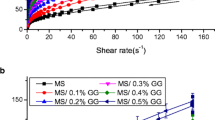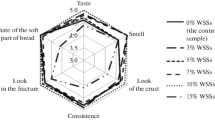Abstract
Red sweet peppers are good sources of antioxidant compounds, such as fibre and carotenoids. Therefore, innovative products that may replace traditional ones, such as white sauces enriched with red sweet pepper, should be developed to improve their functionality. The aim of this work was to study the rheological behaviour, microstructure, syneresis, colour, sensory characteristics and consumer acceptability of new white sauces enriched with red sweet pepper. The results of the rheological studies (viscoelastic behaviour) showed that in the available frequency window all the sauces showed a predominance of the elastic modulus versus the viscous modulus. The effect of incorporating red pepper on the rheological properties depended upon the type of starch used. Microstructure of native starch sauces showed a complex matrix composed of protein and amylose and amylopectin leached from the granules that have been disintegrated during the sauce elaboration. Fat globules were homogenously dispersed and associated with the protein phase. Modified starch sauces showed more swollen starch granules compared with native starch sauces and a protein matrix stabilising the fat globules. All the sauces exhibited considerable intrinsic autofluorescence due to the presence of carotenoids from the red pepper. Consumers scored the modified starch sauces regardless of the starch concentrations based on their highest overall liking and found them beneficial for health. Therefore, new white sauces with high nutritional value, high acceptability, good rheological properties and stability against syneresis could be formulated using red pepper and modified starch.






Similar content being viewed by others
References
Kapsak WR, Rahavi EB, Childs NM, White C (2011) Functional foods: consumer attitudes, perceptions, and behaviors in a growing market. J Am Diet Assoc 111(6):804–810
Silva RA, Lima MS, Viana JB, Bezerra VS, Pimentel MC, Porto AL, Cavalcanti MT, Lima Filho JL (2012) Can artisanal “Coalho” cheese from Northeastern Brazil be used as a functional food? Food Chem 135(3):1533–1538
Arias-Aranda D, Romerosa-Martínez MM (2010) Innovation in the functional foods industry in a peripheral region of the European Union: Andalusia (Spain). Food Policy 35(3):240–246
Chang W-H, Liu J-F (2009) Effects of kiwifruit consumption on serum lipid profiles and antioxidative status in hyperlipidemic subjects. Int J Food Sci Nutr 60(8):709–716
Morais H, Rodrigues P, Ramos C, Almeida V, Forgács E, Cserháti T, Oliveira JS (2002) Effect of blanching and frozen storage on the stability of β-carotene and capsanthin in red pepper (Capsicum Annuum) fruit. Food Sci Technol Int 8(1):55–59
Trinidad TP, Mallillin AC, Loyola AS, Sagum RS, Encabo RR (2009) The potential health benefits of legumes as a good source of dietary fibre. Br J Nutr 103(4):569–574
Duma M, Alsina I (2012) The content of plant pigments in red and yellow bell peppers. Sci Pap Ser B Hortic 56:105–108
Faustino JMF, Barroca MJ, Guiné RPF (2007) Study of the drying kinetics of green bell pepper and chemical characterization. Food Bioprod Process 85(3):163–170
Feliciano D, Albisu F (2005) El consumo de platos preparados en España, Francia y Gran Bretaña. In: Distribución y consumo, vol 79, pp 91–103
Arocas A, Sanz T, Fiszman SM (2009) Influence of corn starch type in the rheological properties of a white sauce after heating and freezing. Food Hydrocoll 23(3):901–907
Mandala IG, Savvas TP, Kostaropoulos AE (2004) Xanthan and locust bean gum influence on the rheology and structure of a white model-sauce. J Food Eng 64(3):335–342
Kenny S, Wehrle K, Auty M, Arendt EK (2001) Influence of sodium caseinate and whey protein on baking properties and rheology of frozen dough. Cereal Chem 78(4):458–463
Gallagher E, Kunkel A, Gormley TR, Arendt EK (2003) The effect of dairy and rice powder addition on loaf and crumb characteristics, and on shelf life (intermediate and long-term) of gluten-free breads stored in a modified atmosphere. Eur Food Res Technol 218(1):44–48
Quiles A, Llorca E, Hernández-Carrión M, Hernando I (2012) Effect of different cornstarch types in new formulations of gluten- and lactose-free white sauces with high protein content. J Food Qual 35(5):341–352
Guardeño LM, Hernando I, Llorca E, Hernández-Carrión M, Quiles A (2012) Microstructural, physical, and sensory impact of starch, inulin, and soy protein in low-fat gluten and lactose free white sauces. J Food Sci 77(8):C859–C865
Arocas A, Sanz T, Hernández-Carrión M, Hernando I, Fiszman SM (2010) Effect of cooking time and ingredients on the performance of different starches in white sauces. Eur Food Res Technol 231(3):395–405
Hernández-Carrión M, Guardeño LM, Carot JM, Pérez-Munuera I, Quiles A, Hernando I (2011) Structural stability of white sauces prepared with different types of fats and thawed in a microwave oven. J Food Eng 104(4):557–564
Arocas A, Sanz T, Fiszman SM (2009) Clean label starches as thickeners in white sauces. Shearing, heating and freeze/thaw stability. Food Hydrocoll 23(8):2031–2037
Heyman B, Depypere F, Delbaere C, Dewettinck K (2010) Effects of non-starch hydrocolloids on the physicochemical properties and stability of a commercial béchamel sauce. J Food Eng 99(2):115–120
Francis FJ, Clydesdale FM (1975) Food colorimetry: theory and applications, vol 1. The Avi Publishing Company Inc, Westport, Connecticut
Bodart M, de Peñaranda R, Deneyer A, Flamant G (2008) Photometry and colorimetry characterisation of materials in daylighting evaluation tools. Build Environ 43(12):2046–2058
ISO (1988) Sensory analysis: general guidance for design of test rooms. Standard no.8589. Geneva
Manoukian EB (1986) Mathematical nonparametric statistics. Gordon and Breach Science Publishers Inc., Newark, NJ
Arocas A, Sanz T, Hernando MI, Fiszman SM (2011) Comparing microwave- and water bath-thawed starch-based sauces: infrared thermography, rheology and microstructure. Food Hydrocoll 25(6):1554–1562
Miles MJ, Morris VJ, Orford PD, Ring SG (1985) The roles of amylose and amylopectin in the gelation and retrogradation of starch. Carbohydr Res 135(2):271–281
Auty MA, Twomey M, Guinee TP, Mulvihill DM (2001) Development and application of confocal scanning laser microscopy methods for studying the distribution of fat and protein in selected dairy products. J Dairy Res 68(3):417–427
Guardeño LM, Sanz T, Fiszman SM, Quiles A, Hernando I (2011) Microwave heating effect on rheology and microstructure of white sauces. J Food Sci 76(8):E544–E552
Vázquez-Gutiérrez JL, Quiles A, Hernando I, Pérez-Munuera I (2011) Changes in the microstructure and location of some bioactive compounds in persimmons treated by high hydrostatic pressure. Postharvest Biol Technol 61(2–3):137–144
Hernández-Carrión M, Tárrega A, Hernando I, Fiszman SM, Quiles A (2014) High hydrostatic pressure treatment provides persimmon good characteristics to formulate milk-based beverages with enhanced functionality. Food Funct 5(6):1250–1260
Mason WR (2009) Starch use in foods. In: BeMiller J, Whistler R (eds) Starch, 3rd edn. Academic Press, San Diego, pp 745–795
Guardeño LM, Puig A, Hernando I, Quiles A (2013) Effect of different corn starches on microstructural, physical and sensory properties of gluten-free white sauces formulated with soy protein and inulin. J Food Process Eng 36(4):535–543
Ares G, Dauber C, Fernández E, Giménez A, Varela P (2014) Penalty analysis based on CATA questions to identify drivers of liking and directions for product reformulation. Food Qual Prefer A 32:65–76
Acknowledgments
The authors wish to acknowledge the Spanish Ministry of Science and Innovation for their financial support (Project AGL2011-30064-C02-02) and to the Universitat Politècnica de València (UPV) for the FPI grant awarded to María Hernández-Carrión. Moreover, the authors wish to thank Elsevier for assistance with the English manuscript.
Conflict of interest
None.
Compliance with Ethics Requirements
This article does not contain any studies with human or animal subjects.
Author information
Authors and Affiliations
Corresponding author
Rights and permissions
About this article
Cite this article
Hernández-Carrión, M., Sanz, T., Hernando, I. et al. New formulations of functional white sauces enriched with red sweet pepper: a rheological, microstructural and sensory study. Eur Food Res Technol 240, 1187–1202 (2015). https://doi.org/10.1007/s00217-015-2422-1
Received:
Revised:
Accepted:
Published:
Issue Date:
DOI: https://doi.org/10.1007/s00217-015-2422-1




